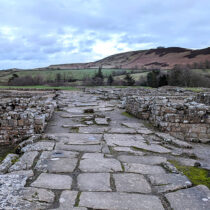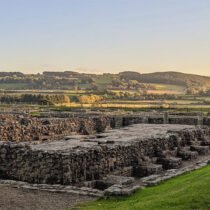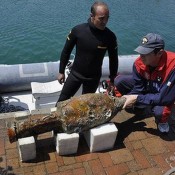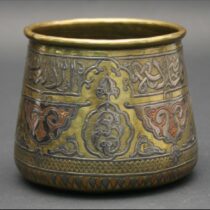Archaeologist Catherine Teitz explores how Roman architecture and everyday life along Hadrian’s Wall evolved over the centuries – and how old excavation records can still yield new insights. She values the strong Roman heritage research network in the Rhine-Main region and lends support to early-career researchers in her field.
When Junior Professor Catherine Teitz leaves the front door, she steps right into her research field. “I live in Mainz’s Kästrich quarter, in the footprint of the Roman legionary camp of Mogontiacum,” she says. Even her daily route to the Institute of Ancient Studies leads through traces of the past: on foot she passes the remains of a late Roman city gate and along the course of the aqueduct. Returning to Mainz after fieldwork, she sees the ancient theater on the train. “It was one of the largest north of the Alps – and I feel incredibly lucky that this city is my home.”
Since last year, Teitz has been teaching and researching in the Department of Classical Archaeology at Johannes Gutenberg University Mainz (JGU), where she focuses on Roman frontiers, architecture, and urban planning. “It’s easy to imagine the Romans in a romantic light – a few soldiers standing on the Wall, gazing into the distance,” she says. “But in reality, it was a massive logistical enterprise: people, animals, materials, food – everything had to be organized.”
Her fascination with the Roman world began early. Growing up in San Francisco, she started studying Latin in middle school – a rare opportunity in the U.S., where modern languages usually take precedence. “That Latin class was as much about Roman history and culture as it was about grammar,” she recalls. “It was the first subject I truly loved.”
From stagecraft to stonework
At Brown University, Teitz studied Classics and Archaeology, while also working in the university theater’s workshop as a carpenter, electrician, and lighting designer. “I’ve always been interested in how spaces work and how people inhabit them,” she says. “Whether it’s a theater or a Roman fort: I want to understand how places function when in use.”
At Stanford University, she completed her PhD in Classical Archaeology, focusing particularly on the frontier settlements along Hadrian’s Wall, which is the monumental northern boundary of the Roman Empire in Britain. A research fellowship brought her to the Romano-Germanic Commission (RGK) of the German Archaeological Institute in Frankfurt, where she turned her attention to the history of her own discipline.
“I looked at the relationship between Eric Birley, a British archaeologist, and the RGK. Through correspondence in the archives, I traced the intellectual networks and exchanges between Britain and Germany that shaped frontier studies from the 1920s until World War II stopped communication,” Teitz explains. “Surprisingly, those academic connections endured and were quickly renewed after the war.”
“Send more socks!”
Hadrian’s Wall has never quite let her go. After completing her doctorate, Teitz worked on research projects in Britain, affiliated among others with the Vindolanda Trust, before joining Mainz University in May 2024. Today, her work moves between Mainz and northern England, where she continues fieldwork at the Roman sites of Vindolanda and Corbridge – two of the most significant, yet strikingly different sites along Hadrian’s Wall.
“At Vindolanda, the saturation of water in the soil has preserved rare organic materials – thousands of leather shoes, textiles, and above all the famous wooden tablets with letters and records of military daily life,” Teitz explains. “A decurion requested more beer for his soldiers while another letter mentioned that socks, underpants, and sandals had been sent to the recipient. Some things never change!”
In Corbridge, by contrast, archaeologists uncovered the site’s extensive stone architecture as early as 1906. Over time, the early fort transformed into a bustling settlement with markets, workshops, and administrative buildings – and the early excavations left behind detailed reports.
It’s these architectural transformations that fascinate Teitz. “A Roman building was rarely static,” she says. “It was expanded, repaired, or repurposed over decades and centuries.” She’s especially interested in how structures were adapted and rebuilt, with new walls rising atop old foundations – from timber beginnings to the stone structures of late antiquity. “At Vindolanda, for instance, there are nine known forts layered on top of each other.”
Reconstructing the record
Archives are central to Teitz’s work. “Many excavations, like those at Corbridge, took place more than a century ago, with results recorded in handwritten notes, sketches, and photographs,” she explains. “Often, those original documents contain details missing from the published reports.”
She digitizes these so-called “legacy data” and integrates them into modern geographic information systems (GIS). These are digital maps that make it possible to link modern surveys of a site with excavation documentation, including the findspots of objects and the plans of buildings. In this way, she can trace patterns of development that might otherwise have vanished over time. “For Corbridge, I’m currently producing the first comprehensive GIS that brings together historical excavation plans and newly-collected data.”
Yet Teitz’s research goes far beyond bricks and blueprints – it’s ultimately about people. “Roman frontiers weren’t rigid lines; they were dynamic, porous, and socially diverse,” she says. “Alongside soldiers lived their families, merchants, and craftspeople – a whole community on the edge of empire.”
Animals, craftspeople, networks
Inside the fort walls and in the vici, i.e., the civilian settlements that grew up outside the forts, the official site plan often collided with the improvisations of everyday life. “Whether a building quietly fitted into an existing street or boldly pushed into public space – those are the kinds of questions that interest me,” says Teitz. “They leave visible traces in the archaeological record.”
Logistics, too, are central to her research. “A military site never existed in isolation,” she explains. “You have to ask: How many people did it take to keep a fort running? Where were supplies stored? What kind of infrastructure supported it all?” Roman frontier systems, she adds, were vast logistical operations involving not just soldiers, but also animals, craftspeople, and transport networks. “We’ll never fully reconstruct their experience, but we can imagine it: the weight of a soldier’s twenty-kilogram pack, the distance he could march in a day, the feel of long journeys on horseback.”
In Mainz, Teitz values not only the immediate presence of Roman heritage all around her, but also the strong network of research partners – including the Rhine-Main Universities Alliance and the Leibniz Center for Archaeology (LEIZA). She is part of disiecta membra, a long-term project funded by the Mainz Academy of Sciences and Literature. “It’s an enormous 24-year effort to systematically document every Roman stone architectural fragment in Germany,” she explains. “The concept is that not only each piece will be catalogued, but they will also be linked to the related structures and the actors who studied them in a massive database. Drawing this information together, the project aims to understand how the architecture and urbanism of Roman Germany developed.”
“We can’t dig up the past again”
Last summer, Teitz co-organized an international workshop for early career researchers through JGU, together with the Romano-Germanic Commission and the Roman Frontiers Early Career Researchers Network. Thirteen PhD students and postdocs from seven countries came to Mainz and Frankfurt to exchange ideas and build connections.
“We can’t excavate the past over again,” says Teitz. “Archaeological data, and the details, are easily lost if no one works with it. That’s why it’s so important to involve early career scholars. They keep this historic information alive and find new ways to build on it.”
Alongside intensive research sessions in the RGK library, which is the largest in Europe devoted to Roman frontier studies, the program included presentations and excursions to archaeological sites. For Catherine Teitz, Mainz could hardly be a better place to explore the ancient world – and she’s reminded of that every day on her way through the city.








